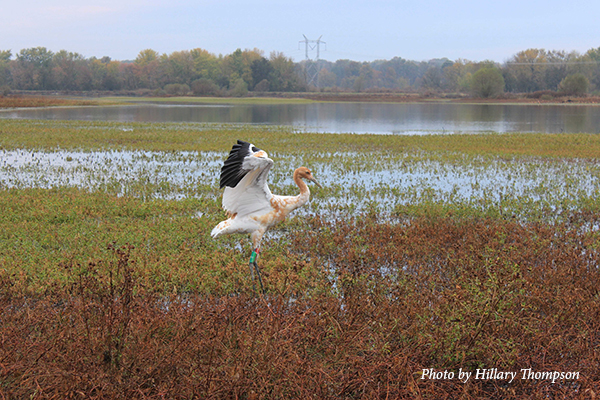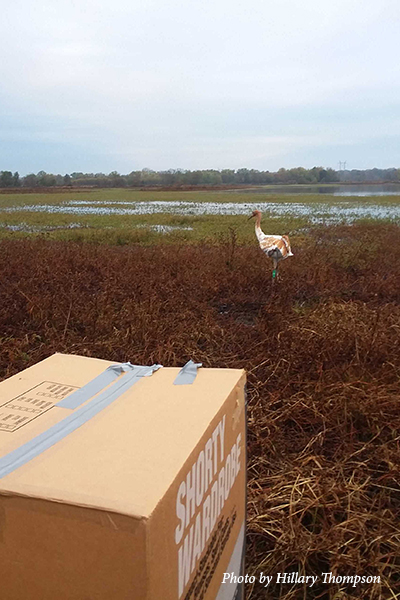
Media contact: Pamela Seelman, Marketing Director, International Crane Foundation, 608-356-9462 ext. 120
Linton, Ind. – The International Crane Foundation this fall successfully released Arya, a female juvenile Whooping Crane, in the Goose Pond Fish and Wildlife Area in southwestern Indiana.
“This November, Goose Pond served as the ideal release spot for Arya,” said Melanie Cowell, Whooping Crane Outreach Program Assistant at the International Crane Foundation. “Indiana provides crucial habitat for stopover and wintering sites for endangered Whooping Cranes.”
The young crane is part of the International Crane Foundation’s parent-rearing program, where juveniles are reared at the foundation’s headquarters in Baraboo, Wisconsin, by adult cranes. In the fall, the juvenile Whooping Cranes are released in the wild near other Whooping Cranes, hopefully, to join the adults as they migrate south as part of the Eastern Migratory Population. In this case, Arya was driven down from Wisconsin and released by the International Crane Foundation and the Indiana Department of Natural Resources (IDNR) staff on a carefully chosen plot of Goose Pond.
“The moment of release was a happy one,” said Cowell. “Arya, who will be known in the wild as ‘80-19,’ emerged from her transport crate, looked around at her new temporary home and took her first flight in the wild around the wetland.” Later that same morning, she met up with two wild hatched adult Whooping Cranes. So far this fall, 18 Whooping Cranes have been counted at Goose Pond. “Most likely, they will mix into Sandhill Crane flocks on their route south,” Cowell explained.

“Whooping Cranes are the rarest crane species in the world. The fact that they can reliably be seen in Goose Pond Fish and Wildlife Area, Jasper-Pulaski Fish and Wildlife Area and surrounding areas makes Indiana a very special place,” said Cowell. Named for their loud and distinctive calls, Whooping Cranes once lived throughout much of North America.
The Whooping Crane’s recovery is one of conservation’s most inspiring stories. Back from around 20 individuals in the 1940s, the species numbers approximately 826 birds today. In addition to working with the Whooping Crane Eastern Partnership (WCEP) in critical conservation efforts, the International Crane Foundation also works with communities in both the central and eastern flyways to raise awareness and excitement about this charismatic species.
The best way to watch Whooping and Sandhill Cranes is to visit Jasper-Pulaski in Medaryville and Goose Pond in Linton. “Both are both reliable places to see cranes,” Cowell added.
More than half of the Eastern Migratory Whooping Crane Population and thousands of Sandhill Cranes migrate through and winter in Indiana. Jasper-Pulaski has an observation platform perfect for watching cranes during migration. Cranes are best seen at sunrise, taking off from roost or socializing, and at sunset.
Although most reliably seen from the viewing platform, they also can be seen from the road on other parts of Jasper-Pulaski property. In mid-November, IDNR counted almost 20,000 cranes in one morning. Occasionally, Whooping Cranes can be seen mixed in with Sandhill Cranes.
Help protect endangered Whooping Cranes by learning a few identifying characteristics. Whooping Cranes are 5 feet tall, have a white body, red on top of their head and a black mustache that runs along their cheeks. Their black wing tips are visible in flight.
Give Whooping Cranes space and appreciate them from afar. If you encounter a Whooping Crane in the wild, please give them the respect and distance they need. Do not approach birds on foot within 200 yards. Remain in your vehicle and get no closer than 100 yards. Also, please remain concealed and do not speak loudly enough that the birds can hear you. Finally, do not trespass on private, state or federal property in an attempt to view or photograph Whooping Cranes. If you notice suspicious or unethical activity towards the cranes or their habitat, please report this activity to the IDNR at 1-800-TIP-IDNR.
To learn more about Whooping Cranes and the other 14 crane species supported through the work of the International Crane Foundation, visit www.savingcranes.org.
Can’t get enough of our North American Cranes? Come see International Crane Foundation staff and meet our Whooping Crane mascot, Hope, at the 11th annual Marsh Madness this winter from Feb. 28 to 29 in Linton. Every year, Friends of Goose Pond celebrates the diversity of species that Goose Pond now supports after its conversion back to a wetland. Marsh Madness includes events, tours, talks and vendors and all are invited.
